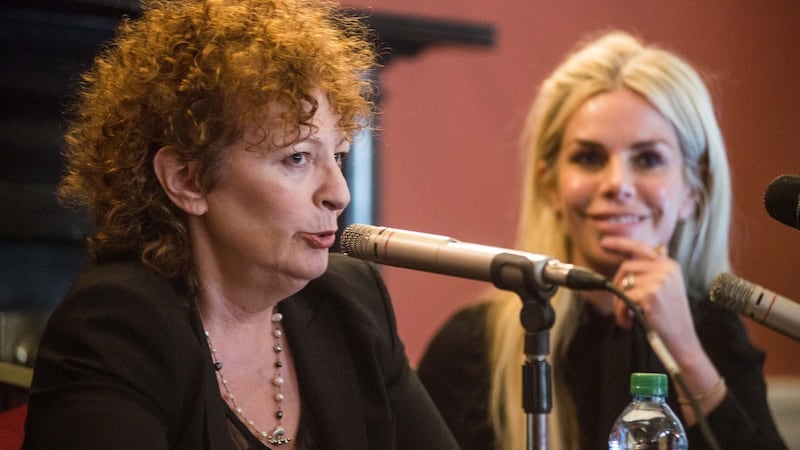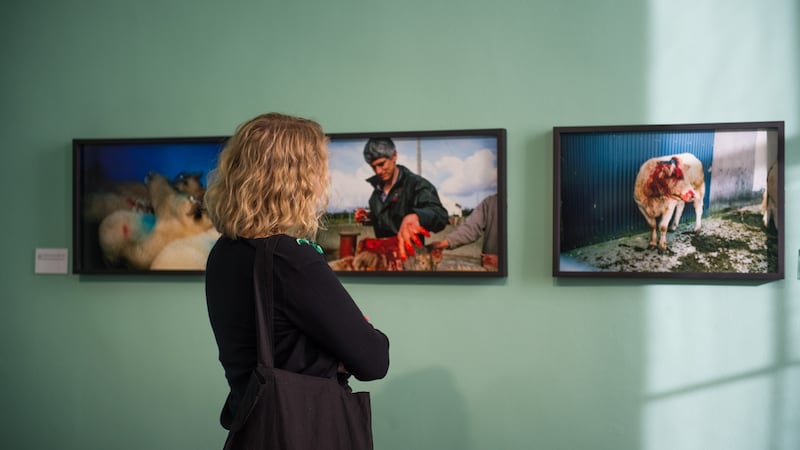At Thanksgiving in 1978, the year after the US photographer Nan Goldin moved to New York, she was heading to dinner in a British man's house with a bunch of ex-pats. Enter Vivienne Dick, a Donegal woman who had begun to make Super8 films that would become seminal works of that particular time in New York, often categorised as "no wave". Dick was wearing a short striped orange and green mini dress. "For me," Goldin says over sparkling water in the Shelbourne Hotel in Dublin, "it was friendship at first sight."
That friendship is made visible with two shows side-by-side at the Irish Museum of Modern Art (Imma): Goldin's Weekend Plans and Dick's 93% Stardust.
Goldin’s photography was prophetic. Before friends were sharing every micro-moment of their lives, before grunge, before heroin became a wry fashion aesthetic, Goldin’s images encapsulated the cycle of lives in all its rawness and realness, devoid of marketing or irony.

Goldin's The Ballad Of Sexual Dependency (1985) depicted around 700 photos of her friends' lives on the Lower East Side of 1980s New York. It's reverberations are still felt in countless parts of contemporary culture, from fashion editorials to club or "scene" photography.

Dick’s work, though, is still under-appreciated. Goldin says she doesn’t feel Dick has received the attention she deserves, calling her a “superstar”. Dick appears in nearly a third of Goldin’s photographs: “I’ve never centred so much on one person or one place.” Along with the portraits of Dick, there are also photographs of Goldin’s travels to Ireland which have never been exhibited before.
“I guess I’ve made some compromises in my life, not a lot,” says Goldin. “I’ve managed to maintain my integrity. But I don’t think it would even occur to [Dick] to compromise. She’s her own person. She’s her own artist. And she’s never done anything but that in her life.”
The week before we meet, Goldin was working with Dior: “I didn’t want the clients on set. I didn’t know that the world had changed so much that that was outrageous . . . So that’s a compromise I wouldn’t make. . . [I] had a chance on a campaign and I lost it because I didn’t feel comfortable having people watch me, looking for my process.”
Weird mixture
The previous day, Dick walks through her show, her films on screens in front of seats made from yoga blocks, with speakers overhanging. "It feels it belongs to another time," she says as we sit down in front of one, which switches between a New York apartment and a man called Jackie Crawford, who was involved in the Troubles, talking about the McDonald's strike in the fast food restaurant in Dublin in 1979.
Shooting on Super8 was liberating for Dick; she didn't need a tripod, and someone would just hold the microphone
“It is a weird mixture of fiction and documentary, it’s both. I think my films are difficult to put into a genre.”
Shooting on Super8 was liberating for Dick; she didn’t need a tripod, and someone would just hold the microphone. Different sounds from the environment bleed in. “Just like in the picture, things kind of slip in that are slightly out of control, things that just happen to be there.”
She is conscious her films are on the ascent again. “It was appreciated at the time but then I went to live in London and it was as if [the films] were on the shelf. They were shown occasionally. But lately, every year there’s screenings now. When I showed these films in Dublin upstairs in a pub on Parliament Street, it was packed out, loads of young people my age came to see them in 1980, 1981. Young people could relate to the films, but the [Irish] Film Board or any of those people couldn’t. It just seemed to make them really mad or something. They couldn’t get the head around how you could make a film without a script.”
Goldin left home when she was about 14 and never lived with her family again. "It was important to me, the way I developed, that I didn't stay in my nuclear family. It's also why my friends have always been my family. I mean it's become a trite kind of statement – 'the chosen family' – but when I first wrote about it in 1985 in the Ballad book, it wasn't trite then. It was still a kind of new notion to people . . . They're the most important to me in the world, my friends. More important than family, lovers, my career."
As a child, Goldin was told to worry what the neighbours think. “That was the gospel.” Her work is perhaps a reaction to that doctrine, “I wanted to raise the window shades of the neighbours, and my own.”
Hunger for attention
Now, she says, “The world is saturated with imagery that previously would have been kept private. And that was one of my stated goals, to make the public private, but I didn’t know it would turn into this superficial barrage. Nothing is private now.

“People post the worst kind of things about themselves. The kind of hunger for attention is running the whole society now. Everybody wants to be famous, for nothing. For no talent or vision, just famous.”
By the 1990s, most of Goldin's friends were dead, victims of Aids and drug use. In 1989, Goldin curated the landmark exhibition Witnesses: Against Our Vanishing. A review in the New York Times by John Russell said, "Witnesses is not primarily an art exhibition. It is an attempt to bear witness in terms of art. If some of it is unpleasant and disturbing, it could not be otherwise."
The scars of Aids are still raw on Goldin’s psyche. Her eyes and voice lower. “It changed everything. Everything. I lost all of my friends. And I kept thinking I’d wake up and it wouldn’t be true. I thought that for years.”
Goldin’s first friend died of the disease in 1982. “There was no safe sex information. The [Catholic] Church was speaking vilely against safe sex. I watched my friends many times be refused sit in restaurants or deli counters. People weren’t allowed in when they had Kaposi [sarcoma, a tumour caused by the HIV virus] on their faces. Now I see people my age who obviously survived but they’re so wasted. They look like skeletons. The face of the disease is still stamped on the world.”
Goldin is keen to hear about the current HIV epidemic in Ireland, where HIV diagnoses have increased 35 per cent since 2011, and last year saw the highest number of new infections ever.
There is perhaps a line that can be traced from Dick and Goldin to Chris Kraus and Lena Dunham.
“Women seem to need to put out stories of themselves to connect with each other and to make their roles known,” Goldin says. “I noticed in the early 90s I was around a community that was male and female. I noticed that men believed what they say and women live in a state of ambivalence. And men often don’t understand it. That was in 1989, I hope things have progressed, because I’m not around as many straight people. I’m sure it hasn’t.”
Dick’s film
Watching Dick’s film at Imma, a woman pops up on the screen describing something in an exaggerated and freewheeling manner.
“This is her apartment in New York and she’s a very extravagant character, but that’s who she was every day. It’s like her life was a performance,” says Dick. “It’s fascinating. It’s very difficult to get people to relax in front of the camera.”
“With emotions,” she says, “sometimes when things happen in our lives, you can suddenly catch yourself catching on to how you’re responding to something. It rolls around like you can’t get to your real emotions. As if you say something and then it feels, ‘that’s like a performance’.”
Dick is understated, softly spoken, economic with her words. Goldin takes notes throughout the interview, asking questions about Ireland's progression in terms of gay rights, women's rights, the power of the Catholic Church.
At a talk in Imma, she relays a story of getting into trouble with a university when she suggested that if a female student wanted to take photographs of prostitutes, then she too must “turn tricks”.
Misogyny seems to run in the veins of men, and they have to be un-taught it. I don't know if they're born with it or they just learn it
Both artists are also untangling relationships between genders. “What is the relationship between men and women about?” Dick asks. “Why is it about one dominating the other and has been for centuries? My theory is that I think the masculine of the world thinks itself to be superior to anything else, especially white, male. We kind of know this. It’s a very, very deep thing. It’s deeper than anything like ‘equal pay’ or anything like that. It’s very primal.”
“People have asked me if I’m a feminist,” Goldin says, without prompting. “My belief is that if you’re a self-respecting woman you’re a feminist. Just that act of self-respect is feminist. I remember being five years-old, I remember where I was standing and what I was wearing, saying ‘I will never let anybody prevent me from doing anything my brothers do’. So I feel like I was born with a feminist heart and that it was never an ‘ism’ for me.
“There is homosexual misogyny, there’s trans misogyny. Misogyny seems to run in the veins of men, and they have to be un-taught it. I don’t know if they’re born with it or they just learn it from their environment from a very early age. That can be talked about for hours.”











